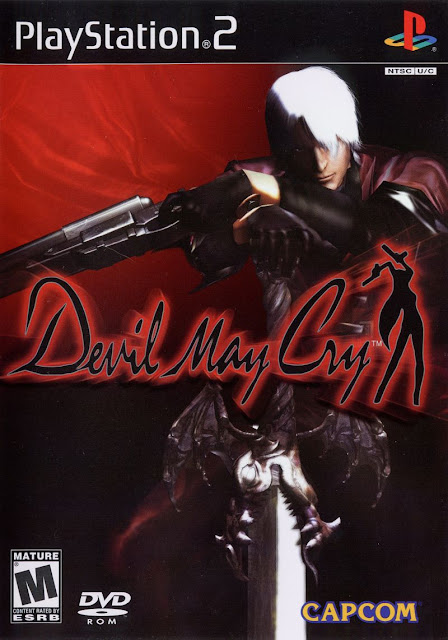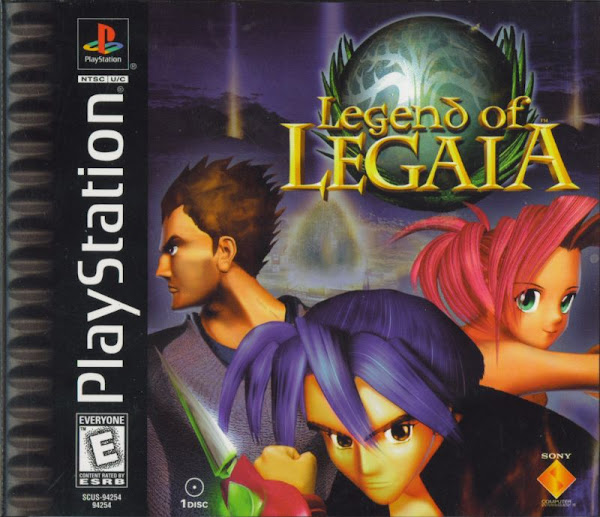Devil May Cry
 |
| Released on October 16, 2001 for the Playstation 2, Devil May Cry features fast-paced and furious 3D hack-n-slash gameplay. |
I've got a confession to make: until Devil May Cry this week, I'd never played through a PS2 game. I've been a Nintendo fanboy since the 80's and only made concessions for SEGA since then...mostly. In 2003, a friend felt sorry for the copy of Chrono Cross that'd been sitting on my shelf for years (when your favorite game of all time gets a sequel, you buy it, console or not), and gave me his old PS One so I could play it. I did, playing through not just Chrono Cross, but a copy of Castlevania: Symphony of the Night he sent me, as well. Those were two damned good video game experiences, but still, I never played through a single other Playstation game. I recently pulled out that old PS One, thinking maybe I'd finally play through another Sony product, only to find the console no longer worked. I decided, instead of replacing it, to just get a PS2, as a PS2 can play PS1 games and has a vast library of its own. I then went to my local retro video gaming store, saw a "like new" copy of Devil May Cry for $7.99, and the rest is history.
 |
| I wish this title screen could be more extreme. |
One thing became immediately apparent after a few minutes into Devil May Cry. Back in the early 00's, I used the GameCube spec sheet to refute Sony fans all the time. "The GameCube is more powerful!" I'd say, pointing at the numbers. I'll be the first to admit that Devil May Cry looks better than many of the GameCube games I've played. The game's protagonist, Dante, is well-designed, highly detailed, and beautifully animated. There's a moment in this game where he jumps out of a horizontal wall of water to the ground below that looks so cool, I gasped. His demonically monstrous enemies look excellent, the game's gothic horror castle environment is darkly beautiful, and weapon and environmental effects look great.
In all honesty, I geeked out on the graphics several times. Early in the game, Dante gains the use of an electric sword. Swinging that sword distorts the air in its immediately vicinity with an insanely cool effect, and I often found myself swooshing it around just to gawk at how cool it looked.
 |
| That's a pretty nice sunset for a demon-infested hell castle. |
The second thing that became immediately apparent: this game is early 00's to the extreme! The opening cinematic features Dante chilling in his tattoo-parlor looking headquarters, as a leather clad female suddenly knocks down his door with a motorcycle. Extreme to the max! It seems that Dante, who's half demon, half human (he looks human for most of the game), is a demon hunter. This motorcycle intruder, Trish, is here to let Dante know that Mundus, the demon emperor who killed Dante's family, is trying to come back to the Earthly plane. Dante isn't having this, and he and Trish head to Mundus' point of return...which just so happens to be an enormous castle of evil.
 |
| I just wish she could have leapt off the motorcycle holding an electric guitar and playing Korn. Dante's already got drums. |
Sure enough, the castle is populated by a vast hoard of demons. Trish mysteriously vanishes as soon as the duo arrive, and it's up to Dante to fight and puzzle his way through the estate's dark halls, down to the pits of hell below, to stop Mundus. At Dante's service is an inspired combat system, where Dante wields not only swords, but firearms. He can switch from sword to gun with the push of a button, creating varied, comboriffic fighting situations. Best of all, the game rates your performance. Lunge forward with your sword, then jump over your enemy and come back down, shotgun blazing, and the game might give you a "cool" rating. Just plug away at the same move, and the game will rate your fighting as "dull."
 |
| Dull? I'm floating in the air, shooting lighting out of my hands at re-animated scarecrow zombies! |
At the end of each level, you get an overall rating. If your rating is high, you get a bunch of red orbs. If it's low, you get...not so many. You can also find these red orbs scattered about levels, and enemies you kill leave them behind--the more powerful the enemy, the more orbs they leave. You can then use the orbs to buy more moves or power-ups, either from stations scattered across the castle, or at the opening screen of most stages. In this way, Devil May Cry features some "RPG-lite" characteristics.
As enemies respawn when you leave, then re-enter a room, you can most definitely grind to more quickly gain stronger, more varied moves, and more power-ups like blue orbs that permanently extend your health meter. There's even an item that temporarily makes Dante invincible, which comes in quite handy during the game's epic boss fights. Throughout the game, Dante also finds better weapons, and you can earn new abilities for these, as well.
 |
| Yes, you look cool, but I'm still gonna tear you limb from limb. |
It's not all sunshine and roses in this demon castle game, though. Devil May Cry was originally slated as a Resident Evil entry, and it is haunted by the fixed camera angles earlier Resident Evil titles are known for. As those earlier Resident Evil games don't feature intense, rapid-fire combat like DMC, the angles are far more of a detriment here. Sure, they look cool, especially at the start of levels where Dante is posed against some groovy, macabre backdrop. However, when you're moving from one area of a room to the next, and the angle radically shifts, the controls invert, and all of a sudden you're running back to where you came from. This control flip is even more frustrating when it happens during a large scale fight--it's not something that's happening all the time, but it happens enough to be annoying.
 |
| I could totally brood in this doorway for hours. |
Also feeling archaic, particularly for a game released in the 21st century, is Devil May Cry's save system. You can save between levels, and at any point during any level, but you always start at the beginning of the level. Thankfully, though, you retain any items you earned before you saved. Even more bothersome is the fact that there's no mission select screen. There's just your save files, with a limit of ten. Considering Devil May Cry features mission-oriented gameplay, and 23 missions, it's a bummer you can't just play any mission you've reached or beaten for fun at any time you want. You can only start playing at the ones where you've saved.
 |
| Somebody tell this boss the floor is lava! Or don't, since I'm trying to kill him. |
While I'm casting stones, the voice acting in Devil May Cry overall isn't awful, but holy cow does the game's script create some cheesy voice-acting moments. "I should have filled her soul with light!!!" is one such moment meant to evoke emotion that had me rolling on the ground laughing at its over-the-top wording and delivery. The dramatic cutscenes are most definitely not the draw here.
The draw is the blazing, fast-paced, innovative, nearly non-stop combat. This is clear quite early in the game when you enter a room filled with bad guys that seem to keep coming and coming, minutes after the room would have been cleared in most other games...and you're happy about it.
Thankfully, the voice acting is the only detriment to the sound department here, as the soundtrack is a blast. Fights are backed by awesome, nu metal inspired rock music, which is switched out for more ambient, creepy stuff when you're wandering around the castle, performing simple item retrieval puzzles. Sword slashes, gunshots, and demon cries are all perfect.
 |
| Every time I try this in the library, they shush me. |
When I did my research for this review, I came across quite a few references to the game's difficulty--apparently, Devil May Cry has a reputation for presenting quite a challenge. I want to be clear: I truly enjoyed playing this game. However, I did not find it to be difficult. I barely cracked double-digit deaths across the breadth of the game, and a third of those were against Devil May Cry's massive final boss, which involves a different gameplay style from much of the rest of your adventure.
I think Devil May Cry's difficulty is very balanced--you can't just mash buttons, but have to actually think about what you're fighting against, and how to best use your skillset. Also...I did treat the game like an RPG, and grinded throughout. I earned most of Dante's moves early on, and always had a full set of items at my disposal, particularly making sure I was well-stocked for boss fights. I did all this, and still beat the game in ten hours. If you do find the normal mode too difficult, though, you can unlock an easy mode very early in the game, for what I guess is a more relaxing experience. You can also unlock a "hard mode" after beating Devil May Cry's normal mode, which actually is pretty hard, though it doesn't change the fact that this is a short game.
 |
| I wonder if my wife would be cool with us getting this statue for our room? |
However, even with some warts, this game is fun as hell, and that's hell in the metaphorical sense, as all the over-the-top gothic notes, insane action, and EXTREME character design makes the entirety of Devil May Cry's ten hours a blast. PS2, I think I'm sold!



Comments
Post a Comment